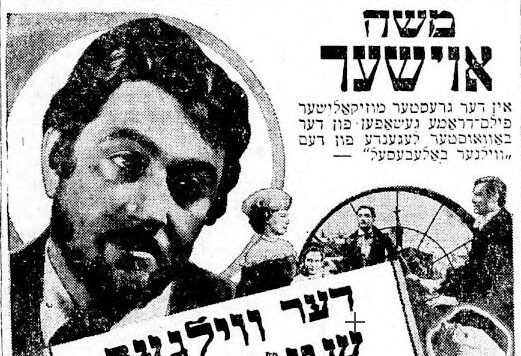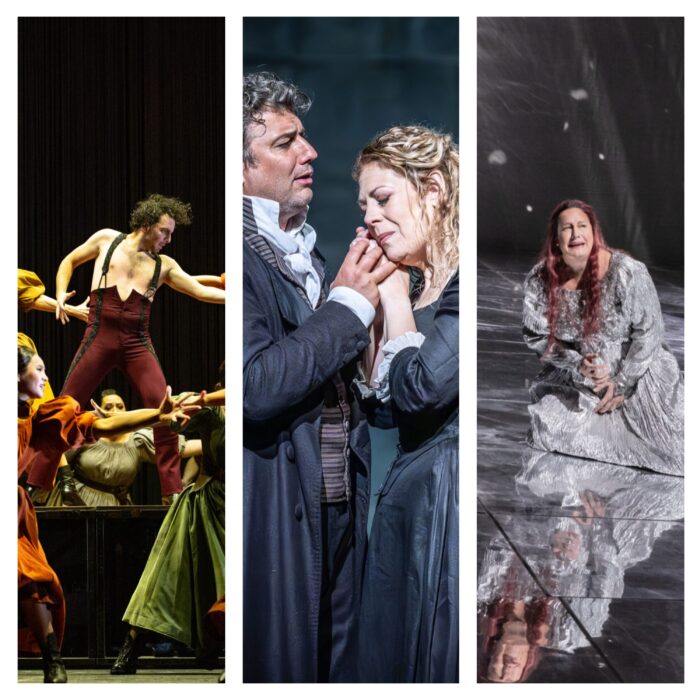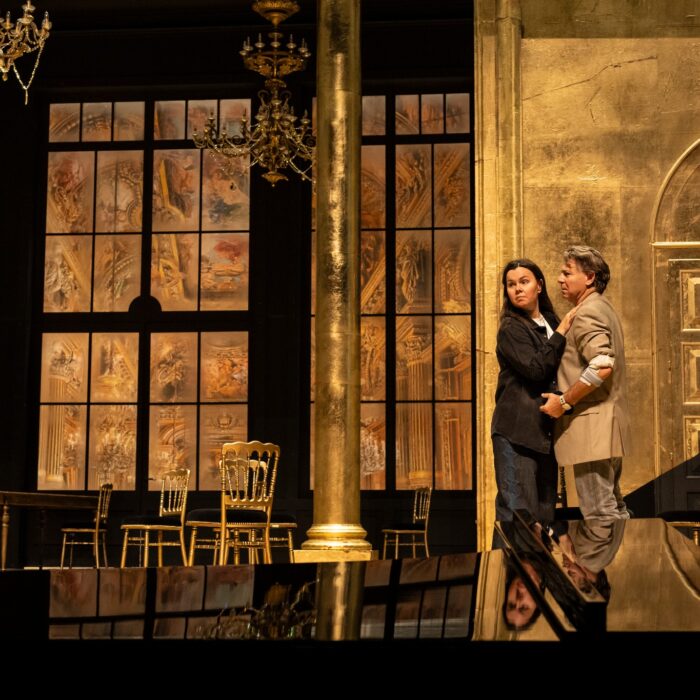
Opera Meets Film: Multimodal Marriages in Daron Hagen’s ‘9/10: Love Before the Fall’
By John VandevertThe nature of cinematography and (classical) singing is long-winded. From some of the early experiments like the acclaimed 1927 film, “The Jazz Singer” by Warner Bros, to the emergence of new giants like Metro-Goldwyn-Mayers Studios (MGM) and their copious amount of opera-laced films like their 1935 film, “A Night at The Opera,” opera on film has had a long development. During the “long-20th century,” many seminal opera-based films were made incorporating some of the world’s most important operatic stars. The 1969 film by Pier Paolo Pasolini, “Medea,” featured the ineffable Maria Callas in the titular role, whilst other contemporary works like Rudolph Mate’s 1959 film, “For the First Time,” also featured stars like American tenor Mario Lanza and Jean-Jacques Beineix’s 1981 film, “Diva.” In the 21st-century, many advancements have been made in terms of technological abilities for expression, with many composers partnering with cinematographers to create pieces of stellar musical art.
Previously, we explored Opera Essentia’s new performance film of their performance of Handel’s ‘Imeneo,’ Edoardo Zucchetti and Michael Spires’ auto-documentary of his career and experiences, and even Mario Bergmann’s cinematic capturing of Polly Ott’s performance of Ambroise Thomas’ ‘À vos jeux, mes amis.’ Recently, another innovative piece of art has captured the attention of the contemporary opera-cinema world, namely Daron Hagen and his new opera film, ‘9/10: Love Before the Fall.’ The plot is centered around a contemporized take on the Orpheus and Eurydice myth by focusing on Orpheus and Charon, the former the fated lover and the latter the ferryman of the underworld. The film can be seen as a neo-Gesamtkunstwerk form of operatic cinema where each and everything seen on the screen, from the cuts to the lighting to the pacing, reflect the internal motivations of the story. Interestingly, this isn’t Hagen’s first film, his first being his 2021 film, ‘Orson Rehearsed,’ whilst three more are being added to his oeuvre (‘I Hear America Singing’ in May 2024, ‘New York Stories’ in 2025, and ‘Deception in Prayer’ [TBD]). Operatically, he’s composed 14 operas thus far, with his compositional skills and musical abilities being praised by composers like Ned Rorem and publications like The Chicago Tribune.
I got the chance to talk with Hagen about several aspects of his creative process and what I learned was a fascinating insight into the mind of a 21st-century artist whose spirit is unchained from a singular medium.
OperaWire: Where did you first craft the film’s idea(s)?
Daron Hagen: I lived in Manhattan for 28 years, and experienced 9/11 firsthand. It happens that I wrote the treatment in New York City in September 2011 as a “one sheet” project proposal for a Guggenheim fellowship, but I had been developing the idea as a project pitch for nearly a decade. The description begins, “We meet and get to know six [six became four as I wrote the screenplay / libretto] New Yorkers the night before their rendezvous’ with destiny not in a taxicab like their Audenesque forebears, but in an Italian Restaurant in New York’s Little Italy.” It must have landed with the committee, because the proposal was accepted; and that acceptance set the project in motion. Conceptually, it began as a staged opera incorporating filmic and electronic elements, but, during production of my “opera film” Orson Rehearsed, it became clear to me that the ideal way to tell the story would be as the filmic sequel to Orson, as it continued my examination of that project’s themes. I have just wrapped filming of I Hear America Singing, which serves as the third installment of what I have come to call The Bardo Trilogy.
OW: How did you deal with challenges of singing and film?
DH: This is a gigantic question, and it is the question. It cuts to the center of my fascination with the making of films that inextricably interweave live vocal performance with pre-planned screenplay. I love and admire singers. If I had begun my life as a filmmaker instead of as an opera composer, I would not find as much raw inspiration in working with actors (and creating an environment that helped them do their work) compelled to maintain a physically healthy alignment to sing while acting as I do. Singing requires an actor to be conversant with being hyper-exposed, larger than life; film requires that they either contain themselves or risk their credibility by being “too big.”
Marni Nixon and I discussed for several years, off and on, the challenge that she faced as an actress and singer in overcoming the emotional disconnect baked into the job of looping someone else’s physical performance. I found the human, aesthetic, and technical issues that we discussed during these conversations terrifically inspiring.
This is the simple answer from the director’s point of view: I’ve tried several ways to deal with the difficulty of documenting singers’ live vocal performances on film. Having them perform with a combination of live instruments and pre-recorded playback served for Orson Rehearsed; combining a character as the violinist Charon, a character (Eurydice), who is heard on the radio but never seen as part of the “canned music” typically heard in a bistro with the live singers served for 9/10: Love Before the Fall; in I Hear America Singing the entire project was filmed with a single camera and boom in a “documentary” sound world with the accompaniment only of the live on screen piano.
OW: Did the acting pose challenges for singing?
Although the difference between musical theater acting singers and operatic singing actors is not absolute, typically, musical theater acting singers lean into characterization and operatic singing actors focus, because their audience requires it, on beauty of sound. A musical theater singer can be a Stanislavskian, or a Method actor, feeling the emotions that the character is experiencing, because their audience interprets their “getting choked up” as emotional authenticity. To maintain proper alignment of the instrument, most opera singers are taught that they cannot risk allowing a Strasbergian remembrance of experience to get them verklempt. Consequently, Classical acting is their usual go-to, as it requires “sticking to the script,” which composers and conductors appreciate. The chamber musician in them cottons to the sort of finding of truth through ensemble building of the Meisner method. Authenticity through collective imagination allows the muscles to remain aligned, and the voice to emerge, physically “unaffected” by the emotion conveyed.
In Robert Frankenberry (who—as he did so beautifully in Orson Rehearsed—switch hit as a performer and as musical director) I had a collaborator with the expertise as a vocal coach to help his colleagues make vocally healthy technical decisions while managing the radical shifts in singing styles central to their roles. For example, Tony’s role was written to be executed by a singing actor; Bibi’s role was written for an operetta-scaled light soubrette; Cory was written for a big-voiced, uniquely American crossover opera/musical theater voice; Trina was written for a contemporary vocal music specialist. The interaction between vocal traditions was everything to me.
OW: The opera is a “rondo” but how did you create structure?
DH: Key centers and characters were coordinated, as I have coordinated them since the beginning of my life as an opera composer. What was new was that I associated specific shot types with key centers. Emotional intimacy was associated with handheld cameras — the more intimate the utterance, the closer the camera. I blocked the arias on the move, circling the bistro, while dialogue and ensembles were blocked as stationary — either seated, or standing still. On a musical level, live” (analogue) performers on the soundtrack coincided with heightened emotion, the stuff of “magical realism,” while “canned” (Midi, or pre-recorded digital sounds) were paired with quotidian dialogue, the stuff of corporeal “life.” The large ensemble with which the opera film climaxes utilizes split screen in order to closely track all four singers in the ensemble; they stand and deliver. On the other hand, the visceral pleasure and fraternity of the “eating” ensembles at table is captured by 360 degree camera moves that serve as ”visual embraces” tying the characters together and celebrating their joy.
OW: What kinds of films do you like?
DH: Orson Welles, of course. Because of his wild brilliance, his ardent humanity, his stubborn faith in the intelligence of his audience. I have a sort of distant, sentimental adoration for Truffaut’s Antonie Doinel films. I saw them at a time when I needed their cool modernism. I love almost anything with Fred Astaire in it. I admire Kurosawa, but I need Cassavetes. Individual films were important to me: Harold and Maude, Casablanca (which is an opera), nearly all Chaplin. Coppola when he is intimate. Nearly everything Noah Baumbach has made so far , because we have the same cultural reference points, and I really get to know his characters.


